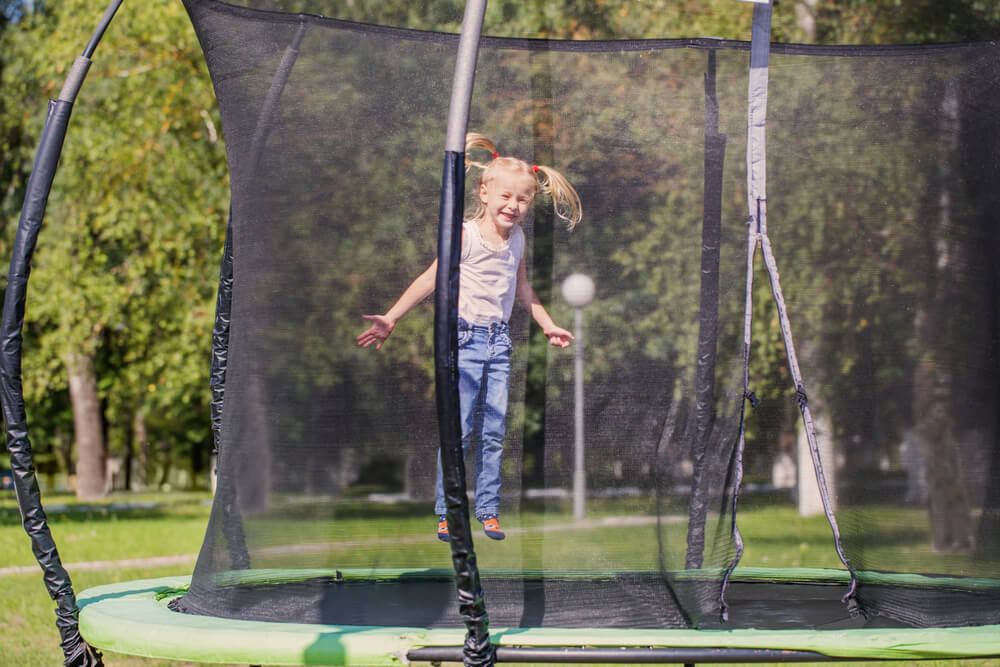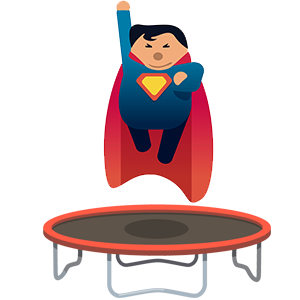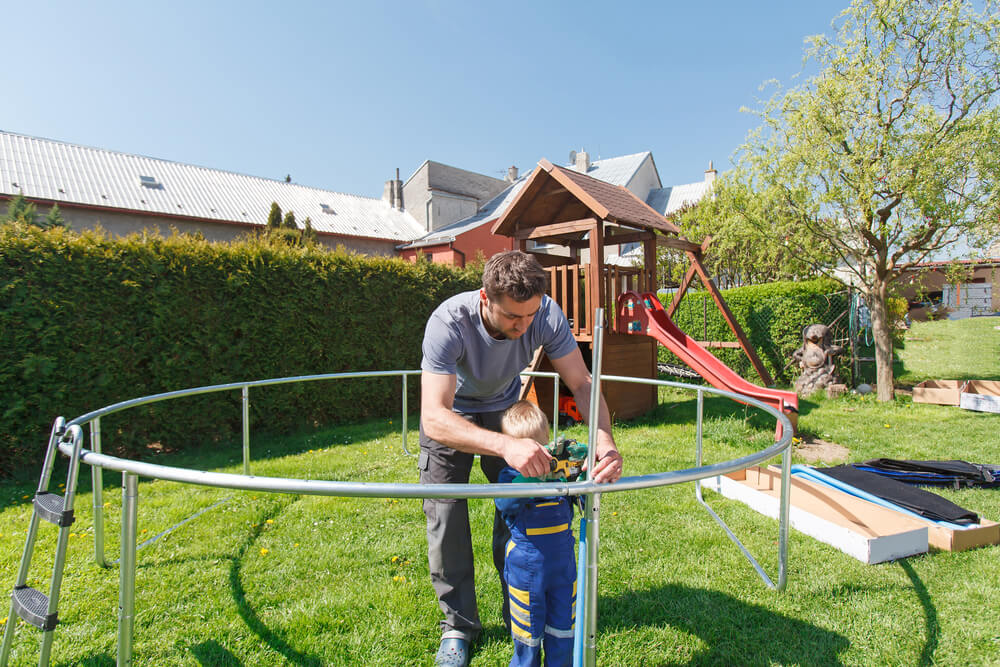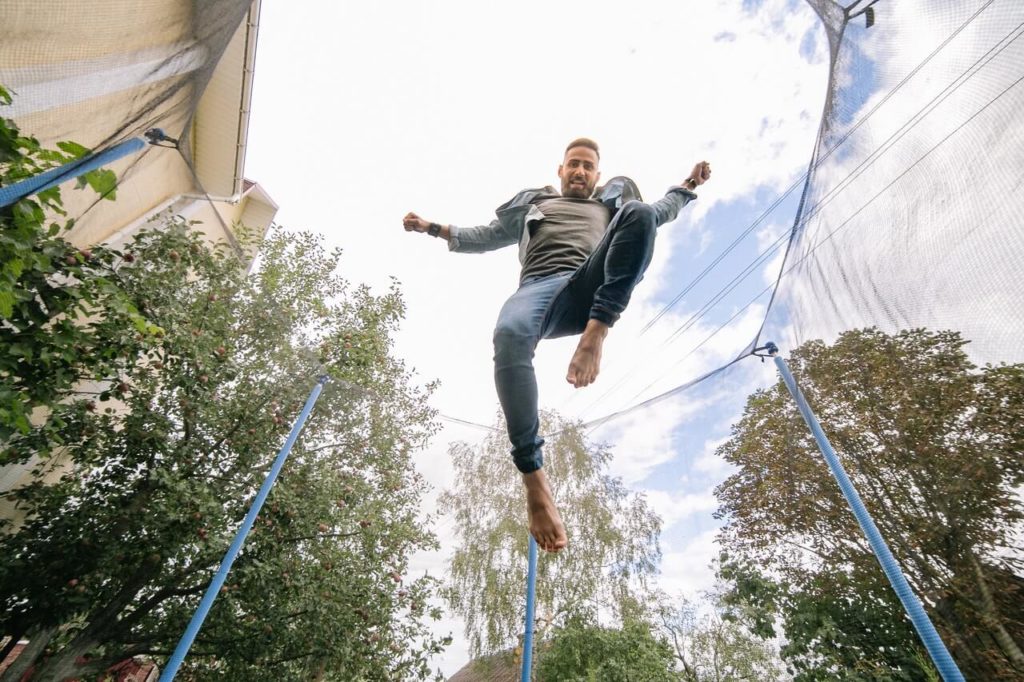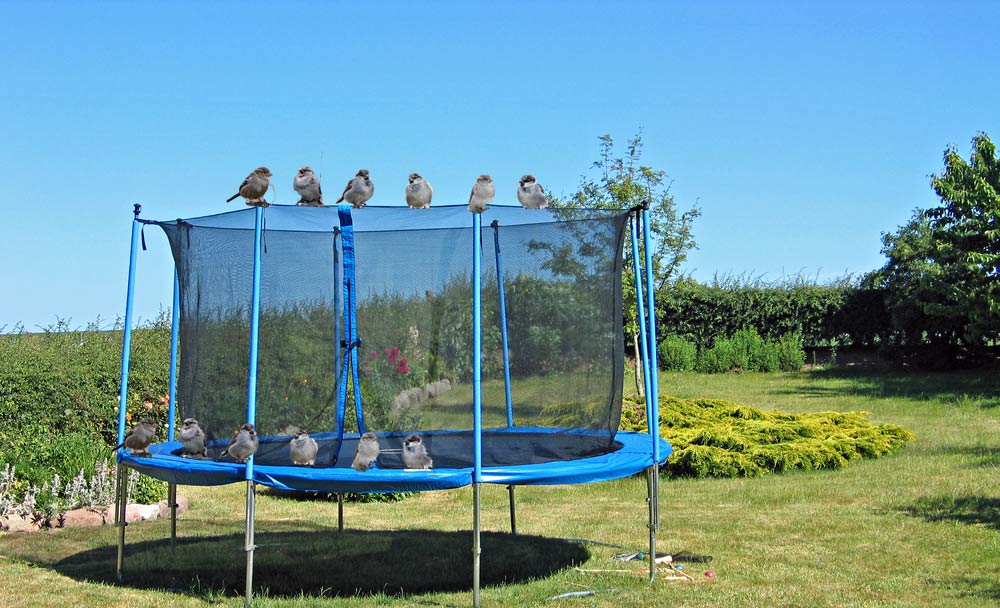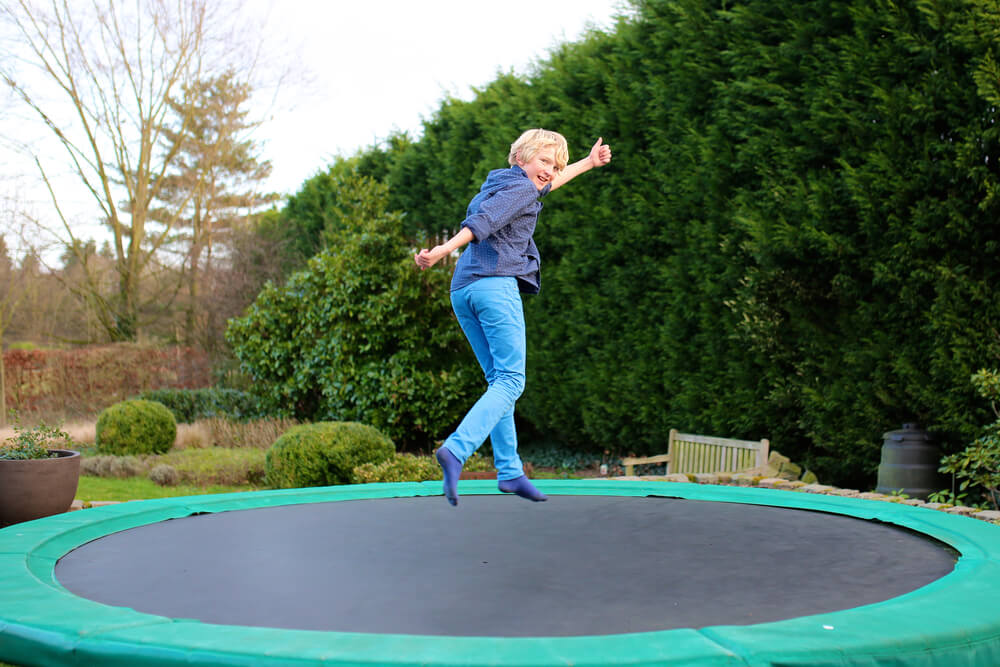Don’t install your new trampoline before you know how far it should be from the fence, where to place it, and how to make it quieter. Read on to learn more
While bouncing on a trampoline is a thrill you’d like your child to experience, safety is always critical.
Other than following the installation guidelines to ensure the unit is sturdy, an important point is where to place the trampoline.
After placing the trampoline in your backyard, you want it surrounded by clear space. That said, it shouldn’t be too close to the fence.
But just how far should the trampoline be from the fence?
Read on to be one step ahead in preventing trampoline injuries (and avoid trouble with neighbors).
How Close Can You Put a Trampoline to a Fence?
The space between the trampoline and the fence should be at least 9 feet.
Does the closeness to the fence matter, given that most trampoline models come with a safety enclosure net? Yes, it does. Thanks for asking!
The truth is, most safety nets have weak zippers, such that if the jumper hits against them at high speed, the net won’t be able to withstand the force. So, if there’s an object, such as a fence, nearby, an injury might occur.
Besides the safety reason, moving a trampoline too close to the fence might pose privacy concerns to the neighbors.
How Much Space Do You Need Around a Trampoline?
If you plan to include a net enclosure, you should factor in a margin of at least 1.5ft between the trampoline and the fence. Be sure to add a total of 3ft to the measurements.
Some trampolines don’t come with an enclosure net. So, if your kid uses a model without a net, add a margin of 8.2ft to the trampoline’s entire circumference. This means a total of 16.4ft is required in that case.
Let’s look at the space needed around different sizes of trampolines.
A 10ft Trampoline
To accommodate a trampoline of this size in your garden, it’s best to create enough room both for the trampoline and its safety margin. So, keep in mind these diameters:
With an enclosure: Allow an of 13ft
Without an enclosure: Allow an area of 26.4ft
A 12ft Trampoline
This one requires more space than the 10ft unit. So, allow for the following:
With an enclosure: 15ft area
Without an enclosure: 28.4ft area
A 15ft Trampoline
Have you acquired a 15ft trampoline? You’ll need plenty of space around it:
With an enclosure: 18ft area
Without an enclosure: 31.4ft area
Can Neighbors Complain about a Trampoline?
Yes, the neighbors might complain that bouncing on the trampoline to peek over the hedge or fence into their home is an intrusion into their privacy.
After the stay-at-home orders took effect in March and April 2020, the number of complaints about noisy neighbors increased in most states around the U.S. For example, in New York, the number of 311 calls skyrocketed by 22%.
So, don’t place the trampoline too close to the fence where people bouncing on it can see directly into the neighbors’ homes or gardens.
Everyone deserves to lead a quiet and peaceful life. So, if the kids’ use of trampoline interrupts a neighbor, complaints might arise. That’s whether the trampoline users see through the neighbors’ windows or scream while jumping.
Where Should I Put My Trampoline In My Yard?
You either own a trampoline by now, or your kids have been begging you to get one and install it in the yard.
So, you’re probably wondering where to place the unit.
Here are some options to follow:
- Look for a clear, flat surface in the garden, free from possible hazards, such as trees, fences, washing lines, hedges, and other equipment.
- Place the unit on a soft, energy-absorbing surface. For example, we recommend you place it on the sand, wood chips, or rubber as these are shock-absorbing surfaces.
- Don’t place the trampoline on a hard surface, such as asphalt or concrete. As people bounce into the hard ground, the force might damage the trampoline’s legs and frame.
Here’s one more reason not to place the trampoline on concrete:
The hard surfaces bar you from securing the unit to the ground with an anchor kit, which often prevents a trampoline from moving in inclement weather.
Should You Place the Trampoline on Grass?
If you prefer keeping a well-manicured garden, you might be concerned about the possible effect of a trampoline on grass.
Well, that depends on a couple of factors, including the type of soil, grass type, the angle the sun rays hit the yard, how the jumping mat was made, and how often you leave the trampoline outside.
When a trampoline is permanently left in the yard without taking precautions to preserve the space beneath the trampoline, the grass below the jumping mat might die.
Here’s how:
A jumping mat filters out direct sunlight to any grass beneath and may impede water from getting to the soil below. This may make it difficult for the grass to survive in the long term.
As a result, the grass lacks nutrients, dries up, and dies.
To ensure that the grass under the trampoline doesn’t wither, you can do the following:
- Move the trampoline around the yard often.
- Occasionally place a sprinkler beneath the trampoline
- Place a synthetic grass mat below the trampoline
Is a Trampoline an Invasion of Privacy?
If you place a trampoline too close to the fence or at a place where the kids jump while looking at a neighbor’s home, the neighbor might feel uncomfortable.
While there are currently no Federal laws citing how trampolines may be an invasion of privacy, it’s advisable to place the unit away from a spot where it may trigger conflicts with a neighbor.
But most people can use other avenues to prove that using a trampoline near their home is an invasion of their privacy. For example, in most states, the Homeowners Association may have by-laws that guide the use of various play structures, including trampolines.
So, the best way is to keep the trampoline away from a spot that may cause problems with your neighbor.
Do You Need Permission to Have a Trampoline?
The answer to this question depends on whether you’re a homeowner or a tenant. So let’s look at both sides of the story.
As a Tenant
If you’re a tenant, you should first check out with your landlord to ensure the equipment is allowed on the premises.
The reason is simple: a trampoline is an attractive nuisance (which simply means the property owner may be liable for injuries to kids who may trespass to come and play on the trampoline).
So, it’s essential to discuss the decision with the property owner before purchasing a trampoline. You don’t want to set yourself and the property owner up for lawsuits down the road.
As a Property Owner
When you own a property, you are the sole decision-maker and can decide whether to bring a trampoline in the yard or not.
But, you should check with the state and local laws to know whether any kind of permit is needed to own a trampoline.
Additionally, before bringing a trampoline on your property, check with your homeowner’s insurance provider to know whether owning a trampoline can alter the policy in any way.
Are Trampolines Noisy?
Yes. Trampolines can be noisy, which can pretty much ruin the fun of bouncing on them.
So what causes the noise in trampolines?
When trampolines are kept away for an extended period without use, rust may start developing on the hinges and springs. So, when jumping on the unit, you’ll hear loud squeaky noises due to the springs rubbing against the metal frame.
The other common cause of the noise is the weather condition, affecting the steel and steel contact areas. For example, moisture or rain may get in, and later, heat may dry up the joints resulting in noise when you or the kids bounce.
How Do I Make My Trampoline Quieter?
Luckily, you can stop trampoline noises in the following ways:
- First, clean the jumping mat as any debris and wetness can cause the mat to produce noise.
- Remove the rust – If you spot any rust on the frame or springs, use a rust remover to get rid of it.
- Clean up the frame with water and dry it in the sun or using clean rugs.
- Grease the trampoline joints
- Use a lubricant on the moving parts using a product like WD-40.
- Tighten loose screws
- Replace worn-out bolts and screws
- Replace any rusty springs
- Use a Springfree trampoline. They cost more but are quiet and safer than regular trampolines.
Wrap up
Whether they have an enclosure net or not, trampolines shouldn’t be too close to the fence.
First, it’s for the safety of the trampoline users, and secondly, it’s to avoid intruding into the neighbors’ privacy.
Most importantly, if you’re a tenant, don’t bring a trampoline to the premises without the landlord’s knowledge. Property owners, too, ought to check if the trampoline can impact the homeowner’s insurance policy.
Lastly, trampolines can produce annoying noises for various reasons. Just do your best to maintain them, and there won’t be any trampoline noise complaints.

